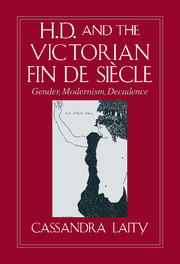Book contents
- Frontmatter
- Contents
- Acknowledgments
- Introduction: Dramatis Personae: The Aesthete Androgyne and the Femme Fatale
- 1 The Rhetoric of Anti-Romanticism: Gendered Genealogies of Male Modernism
- 2 H.D.'s Early Decadent Masks and Images: HER; Sea Garden
- The Aesthete Androgyne
- 3 Writing the Decadent Boy Androgyne: Whiteness, Diaphaneitè, Poikilia, and Male Statuary
- 4 Across Gender, across Sexuality: H.D.'s Male Masking and the Sexual Narrative: Hippolytus Temporizes; “Heliodora”
- The Femme Fatale
- Postscript
- Notes
- Index
- CAMBRIDGE STUDIES IN AMERICAN LITERATURE AND CULTURE
3 - Writing the Decadent Boy Androgyne: Whiteness, Diaphaneitè, Poikilia, and Male Statuary
Published online by Cambridge University Press: 06 January 2010
- Frontmatter
- Contents
- Acknowledgments
- Introduction: Dramatis Personae: The Aesthete Androgyne and the Femme Fatale
- 1 The Rhetoric of Anti-Romanticism: Gendered Genealogies of Male Modernism
- 2 H.D.'s Early Decadent Masks and Images: HER; Sea Garden
- The Aesthete Androgyne
- 3 Writing the Decadent Boy Androgyne: Whiteness, Diaphaneitè, Poikilia, and Male Statuary
- 4 Across Gender, across Sexuality: H.D.'s Male Masking and the Sexual Narrative: Hippolytus Temporizes; “Heliodora”
- The Femme Fatale
- Postscript
- Notes
- Index
- CAMBRIDGE STUDIES IN AMERICAN LITERATURE AND CULTURE
Summary
Reflecting on her recent writings in notes she entitled, “H.D. by Delia Alton,” H.D. tellingly described “the theme and center” of her Hippolytus Temporizes and Hedylus to be “the portrait or projection of the intellectualized, crystalline youth, whose prototype is again found, or first found in the actual Greek drama” (221). Even as her reference to the crystalline youth indirectly suggests Pater's crystal man – frequently his homoerotic ideal of spiritual and physical beauty – H.D. unconsciously echoes Pater's early exclamation over the timelessness of the beloved fair youth in his essay, “Diaphaneitè”: “Over and over again the world has been surprised by the heroism, the insight, the passion of this clear crystal nature.” Indeed, H.D. would seem to be considering the genealogy of her crystalline youth backward, from Aestheticism to the Classicism where she herself “again found” the androgynous type she had earlier discovered in Swinburne's “Hermaphroditus” and other poems.
Following Sea Garden, H.D. appears to have found both a radical individualism and a compatible philosophy of erotic/spiritual twinship in the persona of the Decadent boy androgyne whose “higher” love for his male mentor reconciles both intellect and eros. H.D.'s primary mask for female desire in works such as the verse-play Hippolytus Temporizes (1927), the novel Hedylus (1928), and poems from the volumes Hymen (1921), Heliodora (1924), and Red Roses for Bronze (1931) is largely perceived through the desiring, masculine “gaze” at youthful male beauty familiar in the works of Pater, Wilde, Swinburne, and other Aesthete poets.
- Type
- Chapter
- Information
- H. D. and the Victorian Fin de SiècleGender, Modernism, Decadence, pp. 63 - 83Publisher: Cambridge University PressPrint publication year: 1996



